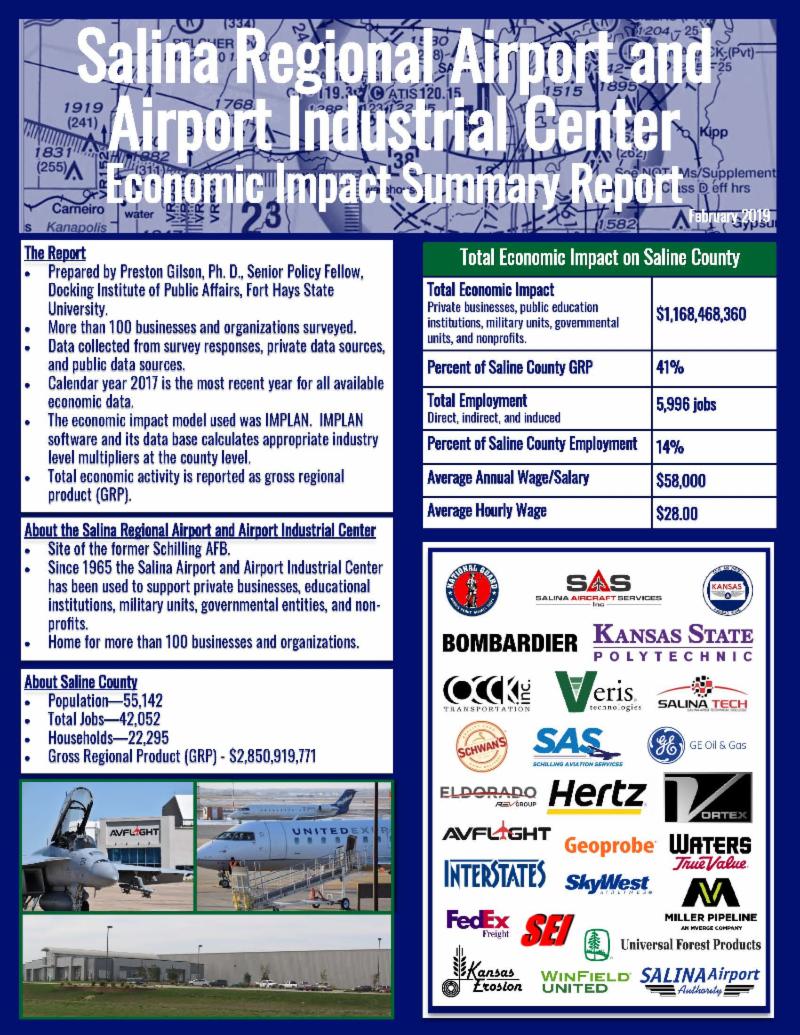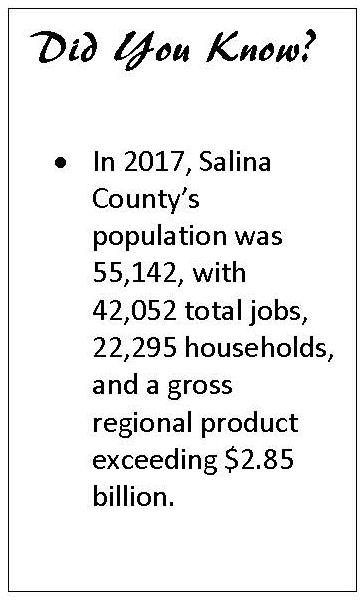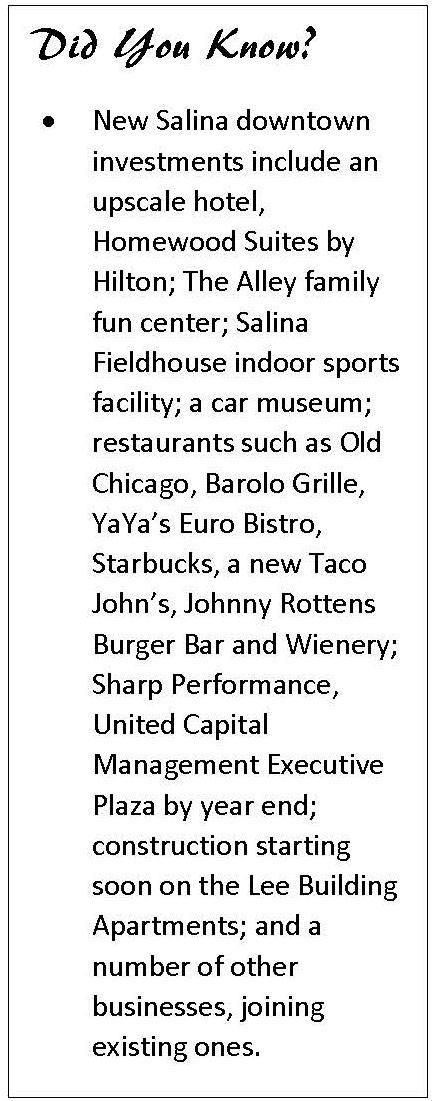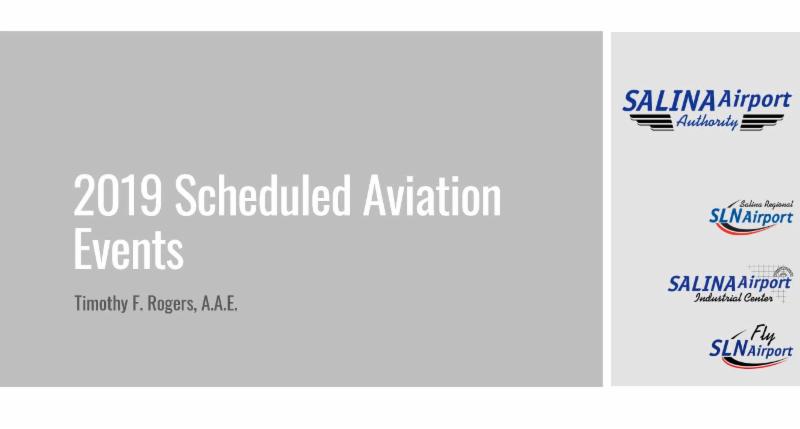|
|
From the XD's Desk:
2019 Aviation Events Impact Salina and Saline County
|

Beginning this May and running through September five aviation events will have a combined and direct economic impact exceeding $3.8 million on our local economy.
The Salina Regional Airport will host aircraft and personnel deployments by NOAA, NASA and the U.S. military. This year's event schedule also includes the Commemorative Air Force (CAF) with their historic B-29, FiFi and the U.S. National Aerobatics Championships.
The five events will bring an estimated 1,225 individuals associated with each organization to Salina for an average stay of 24 days. The direct visitor spending for hangar space, aviation fuel, rental cars, hotel rooms, and dining is an estimated $3,857,480.
Use the following link to learn more about each event and look to the skies above Salina for unique mix of civilian, government and military aircraft arriving and departing the Salina Airport.
Thank you for reading this month's issue of
Reporting Points.
"Aviation is proof that given, the will, we have the capacity to achieve the impossible"
-
Eddie Rickenbacker
Tim Rogers, A.A.E.
Executive Director
Salina Airport Authority
Salina Regional Airport & Airport Industrial Center
|
|
|
|
Airport & Airport Industrial Center still a Major Economic Contributor
|
Tim Unruh
March 2019

A 4,000-acre complex of buildings and runways, that pumped $20.4 million a year into the local economy in 1964, has since sextupled its contribution.
Salina Airport and Industrial Center, that bloomed in western Salina after Schilling Air Force Base closed 53 years ago, today
accounts for 41 percent of Saline County's Gross Regional Product - total market value of all goods and services - and 14 percent of total employment, with 5,996 jobs.
A study by the Docking Institute of Public Affairs, based at Fort Hays State University, compiled an economic impact summary report, using 2017 data, on the important area. Loaded with private businesses, public education institutions, military units, governmental units and nonprofit organizations, the airport and industrial center has again posted a good result.
"It's impressive. The numbers speak for themselves," said Kent Buer, president and CEO of First Bank Kansas and chairman of the Salina Airport Authority board of directors.
The summary placed the aviation- and industry-rich center's annual economic impact at nearly $1.2 billion. "I think that would surprise a lot of people that total economic impact is over a billion dollars," Buer said. "It just goes to show how important the Salina Regional Airport and Airport Industrial Center is to not only Salina, but our entire region. There is a lot going on."
 The rebound continues from a "seismic disaster" in 1965, when Schilling Air Force Base closed, taking with it a sizable chunk of the local economy, according to a 2014 Salina Journal story. As part of the country's Strategic Air Command, Schilling Air Force Base employed 763 officers, 4,244 airmen and 357 civilians - 5,364 jobs, the Journal story reads.
The government gifted the base, its long runway and plethora of airplane hangars, barracks and other buildings, to the community. The City of Salina, Saline County, Salina School District and the State of Kansas diversified the property into a valuable center that has continued to grow.
Among the "myths" is that the airport and industrial area is filled with low-paying jobs, said Tim Rogers, executive director of the airport authority. He agreed that some entry-level jobs start at $15.50 an hour, but the average annual wage is $58,000 or $28 per hour. "There are high value jobs out here," he said.
Board member Kristin Gunn concurs. "They're good jobs, representing work that is highly valued," said Gunn, a retired chemistry and biology teacher at Salina Central High School, and a former Salina city commissioner. "If you simply look at the average wage of $28.00 an hour, these employees probably require more training and education," she said. "A number of positions are supervisory and managerial."
The industrial area is home to more than 100 businesses and organizations, Rogers said, and 80 percent of those surveyed were from larger employers. Airport and Airport Industrial Center total employment of 5,996 jobs accounts for 14% of total jobs in Saline County.
|
|
|
|
 |
|
In Their Own Words - Airport and Airport Industrial Center Pays Dividends
|
Tim Unruh
April 2019

Foresight from Salina and Saline County leaders who reincarnated a
military base during
the mid-1960s, is still paying huge dividends. The diversification of Schilling Air Force Base into an incubator for business, industry, education, technology and jobs, was a huge boost, as the latest Docking Institute of Public Affairs economic impact study reveals.
"It paints a great picture for me," said Bob Vidricksen, chairman of the Saline County commission, referring to the nearly $1.2 billion in total economic impact provided today by the Salina Regional Airport and Airport Industrial Center.
Those who took the lead in transforming the area, aimed first to survive, said Larry Britegam, a longtime Salina banker. Then the city, county and region thrived, thanks to the expertise and entrepreneurial spirit of many predecessors. "There are two words very meaningful to me; risk and reward," said Britegam, president of American State Bank and Trust Company. "In the 1960s, there were some business leaders in the community who took a risk against a lot of odds on whether it would work or not," he said. "More than 50 years later, those risks helped Salina become what it is today."
North-central Kansas' regional center is edging closer to a coveted population of 50,000 people, which brings with it metropolitan status, and enhance federal assistance. Salina is a place where people now come to shop, dine, and board commercial flights to Denver, Chicago - where they can connect to the world - and possibly other major destinations in the nation's belly as the service continues to grow and prosper.
As the Docking report attests, the airport and industrial area can take credit for a big chunk of that advancement. "It amazes me how it continues to grow," Vidricksen said. "Look at the 41 percent of gross regional product. That's an amazing number." The average annual wage/salary - $58,000 - produced in the west Salina center, and the $28 average hourly wage, he said, are equally dazzling. "Everyone thinks Salina is such a low-paying city. Sure, there are entry-level jobs, but that average wage can match with communities anywhere," Vidricksen said.
The airport and industrial center is a vital cog in the local and area economies, according to statements from Eric Brown, incoming president and CEO of the Salina Area Chamber of Commerce, and Mike Schrage, recently promoted Salina city manager.
"Salina Regional Airport and Airport Industrial Center continues to play a crucial role in the everyday economic life of Saline County," Brown wrote. "This data is extremely positive when you see how far and wide the reach and impact is to our region, because of the airport authority's operations and over 100 entities that call the Airport Industrial Center home.
The study continues to show the positive effects that SAA has on Saline County's economic growth and stability." The numbers speak volumes, and serve as a good reminder of the airport and industrial center's importance, according to Schrage.
"
It is easy to lose sight of the number and breadth of the businesses and organizations that are based out of the airport and industrial center. Many of us deal with them on a regular basis without a full appreciation of their combined impact to the local economy," he wrote. "The Docking Institute analysis certainly helps quantify the concentrated economic impact based at the airport industrial area that might otherwise be overlooked."
With more than 361,000 square feet of space available to lease - 31 percent of the total 1.163 million square feet - there is potential for even more impact.
Chances are good, said Mitch Robinson, executive director of the Salina Community Economic Development Organization. "There is a major shortage of quality industrial space across the country. I believe we'll see the vacancy rate continue to go down," he said. The Docking report is a "great tool" to illustrate the airport and industrial center's impact, Robinson said. "This really shows the value of having those companies here in Salina and Saline County."
Does the report suggest a bright future?
"It's the tip of the iceberg for our community," Vidricksen said. "We would like to have everybody in Salina making $58,000 a year. The airport authority is the leader in that regard, from an industrial standpoint." The airport authority helps Salina maintain its stronghold as a regional center that attracts thousands of people from Newton, Hillsboro, McPherson, Concordia and many other towns, who commute to Salina for work.
"Salina is a pillar for a much larger community," said Vidricksen, a lifelong Salinan, along with Britegam. Both graduated high school here and grew up a block apart in a west Salina neighborhood.
"We have Salina Regional Airport and Salina Regional Health Center," Vidricksen said. "We are a regional center, and we're proud of it."
Progress at the airport and industrial center was an inspiration to Britegam - a member of the Salina 2020 initiative - as he helped promote more than $160 million in ongoing upgrades to downtown Salina.
Included are major improvements to Santa Fe Avenue, and a number of new businesses.
"It's how we looked at the downtown project," Britegam said. "Was it worth the risk to take a chance, to maybe have a similar success as those who took a risk 53 years ago, and helped grow our community to what it is today?
"The risk has been taken, and the story will evolve over the next couple of years. We believe it will have a very happy ending."
|
|
|
Soaring for Safety Part of Civil Air Patrol's Mission
|
Tim Unruh
April 2019

Flying over landscapes with eyes peeled for the lost or distressed, or scanning for storm damage, are among the Civil Air Patrol's duties.
The nationwide nonprofit organization, funded in part by the federal government, is proudly involved in a number of functions that keep Salina pilot - Lt. Col. Doug Dutton - busy,
and aids the safety of people.
As a flight enthusiast and a dedicated servant, he wouldn't want it any other way. "I like being able to use my skills as a pilot and leader, and give it back to the public," said Dutton, 56. "I just love flying. That's my release. CAP gives me the ability to fly in a really nice airplane, and take off from a really nice airport."
Dutton was honored to pick up the Civil Air Patrol's newest aircraft in Kansas last year, a Cessna 182 that cost more than $500,000. "It has a glass cockpit and lots of outstanding capabilities, and I love showing it off," Dutton said. Three other aircraft are positioned throughout the state.
Salina Regional Airport has served as the Kansas Civil Air Patrols's base of operations for more than 20 years. Dutton is the Kansas Wing's director of finance, director of aircraft maintenance, and one of the state's senior mission pilots.
If that's not enough, he is a certified public accountant and an assistant business professor at Bethany College in Lindsborg. "I'm not a doctor or a lawyer, so I can't afford to fly this much, especially in aircraft this excellent," Dutton said. "Thanks to CAP, I can do this."
Doug Peters of Windom is currently the Salina Squadron's other active pilot, along with several active air crew and numerous active cadet members.
Officially started in 1941, with operations that began five years prior, Civil Air Patrol is the civilian auxiliary of the United States Air Force. CAP's 61,000 volunteers are "aviation minded" with diverse backgrounds, according to
gocivilairpatrol.com, the organization's website.
The Kansas Wing headquarters is based at 3010 Arnold at the Salina Regional Airport and Airport Industrial Center. The office is staffed from 8 a.m. until noon, Monday through Friday by June Ferguson, the state's lone paid part-time CAP employee. All other state members are unpaid volunteers.
Being a member is highly gratifying, said Col. Linette Lahan, 53, of Junction City, CAP's Kansas wing commander. A 14-year veteran of the Civil Air Patrol, Lahan is a paid civilian worker at Fort Riley. "The thing that makes (CAP) so satisfying and rewarding is knowing that if we're called, we will help as long and as often as we can," she said.
Civil Air Patrol sports 550 light aircraft - four in Kansas - and more than 900 ground vehicles, along with gliders and hot air balloons. A sport utility vehicle at the Salina office is equipped with a hi-tech interoperability radio to communicate with other agencies, such as the Kansas Highway Patrol.
Each state organization is considered a wing of Civil Air Patrol. The Kansas wing currently includes 175 cadets and 238 adult members; 28 of those are from the Salina area. The state has 10 units - Salina, Wichita, Junction City, Manhattan, Emporia, Topeka, Lawrence, Kansas City
(two), and Lenexa.
CAP provides emergency services - assisting local, state and federal agencies - such as search and rescue for the Air Force Rescue Coordination Center, transporting blood supplies for the American Red Cross, water samples for the Kansas Department of Health and Environment, providing damage assessments for the Kansas Department of Emergency Management, Federal Emergency Management Agency, and training support for the Kansas Air National Guard. Some CAP members have been helping to assess flood damage in eastern Kansas, Missouri, Iowa, and Nebraska, Dutton said.
Cadet programs for youths from ages 12 to 18, provide aerospace education, leadership training, and an introduction to emergency services. "It's like a combination of ROTC (Reserved Officer Training Corps) and Explorer scouts," Dutton said.
Kansas CAP cadets can earn the right to be passengers with adult pilots, in both powered aircraft and gliders. Youngsters join CAP at the Cadet Airman Basic level and move through the ranks with the goal of reaching Cadet Colonel, receiving the Carl A Spaatz Award. "It's very hard to achieve. One half of one percent get to cadet colonel," Lahan said. That high honor "can actually open doors to scholarships and opportunities," she said.
Similar to the Eagle in scouting, cadet colonel looks good on a resume, Lahan said, and "at one time, almost one-third of Air Force Academy cadets were CAP cadets."
Civil Air Patrol also takes its program right into the classroom. Dutton's sister, Deborah Martin, a special education teacher in Southern Cloud schools (Glasco and Miltonvale), is among educators who have been equipped to take CAP's message to students. Civil Air Patrol supplies aerospace equipment, such as weather stations, robotics kits, and remote control quad copters to
the school. "Any teacher can join, and there is a teacher flight program," Dutton said.
Civil Air Patrol's education focus is on science, technology, engineering and mathematics.
Many cadets move on to military careers. Their paths take some through military flight academies "which in turn produces young men and women interested in becoming commercial pilots, communications experts, cyber-technology; it's unlimited," Lahan said. "You could have someone interested in astronomy, or manning the International Space Station. It can go as far as that or beyond."
Civil Air Patrol is beginning to incorporate unmanned aerial systems into its emergency services, but the organization is waiting for the technology - and rules from the Federal Aviation Administration - to mature. "The FAA is being very careful in administering that so it doesn't cross any judiciary boundaries," Wing Commander Lahan said. "We are very cognizant of the repercussions of how drones can interfere with flights." Meanwhile, ummanned systems are helping CAP augment its services, she said.
While the organization is busy year round, summer is jam-packed. "We have a lot of stuff with the Red Cross. The need for blood increases," Lahan sad. "Many of the cadet special activities are going on in summer months, when they're not in school." State wings schedule weeklong encampments that are required as cadets advance through the CAP program. Kansas encampments are during winter months. Cadets may attend those in other states, Lahan said, whatever fits their schedules best.
|
|
|
Available Properties
|

|
|
|
 |
|
Feature Facility
Building 313, 2934 Arnold Avenue
|
Located in the heart of the Airport Industrial Center, the SAA's Building 313 is move in ready and right-sized for a business or organization needing a shop and/or warehouse space along with offices. This facility located at 2934 Arnold Ave. contains 11,885 Sq. Ft. of space.
Call the Salina Airport Authority today at 785-827-3914 to schedule a tour or email shellis@salair.org.
|
|
 |
|
On the Flightline at America's Fuel Stop
2019 Aviation Events
|

|
|
|